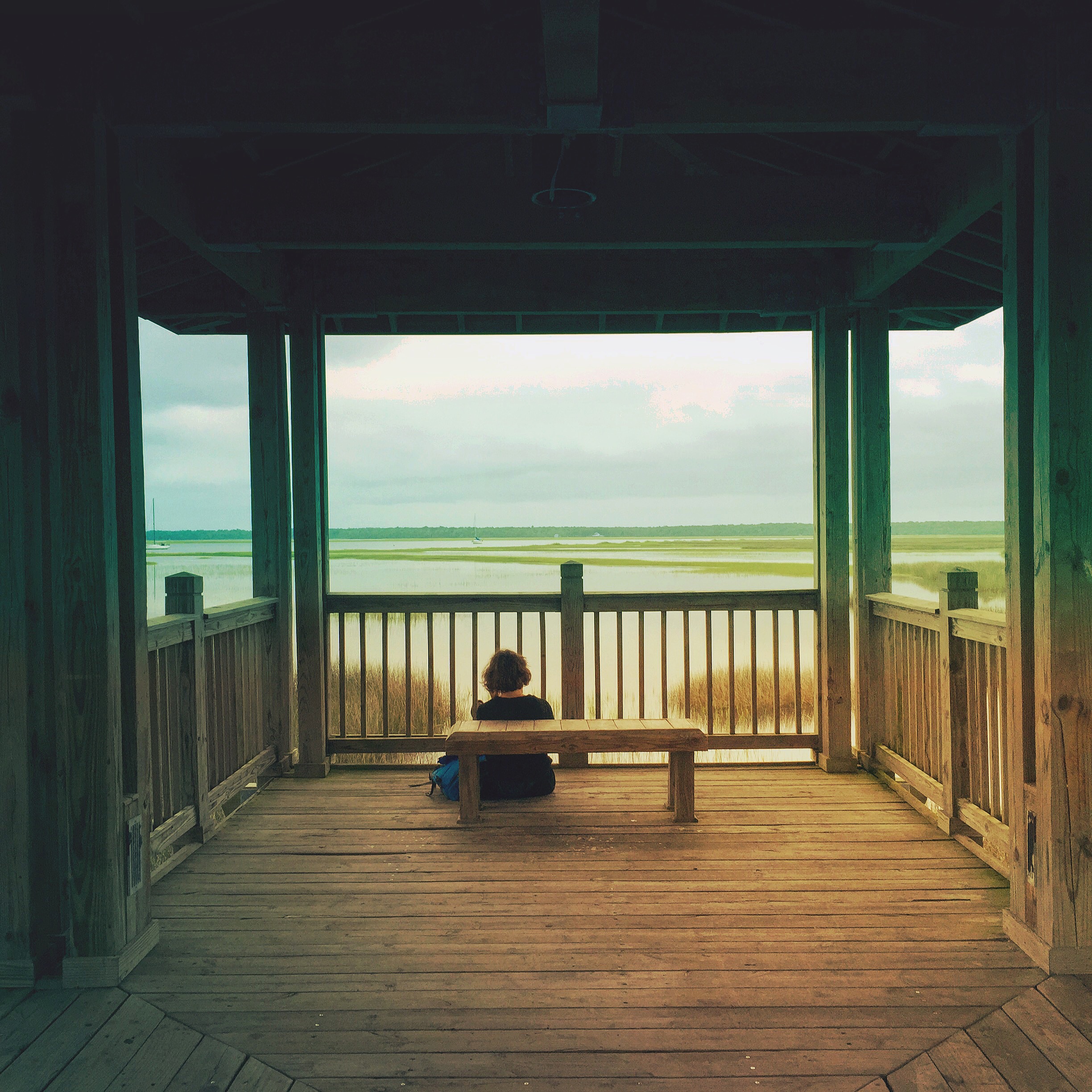CUMBERLAND ISLAND
With a population of fewer than twenty thousand, St. Marys is a sleepy southern town known as the embarkation point for Cumberland Island. The drive down from Savannah is short—only one and half hours. Cute lodgings abound. We rented a cozy, two-bedroom cottage stocked with all the essentials. It had a lovely porch, even a pair of bikes.
As we did in Savannah, upon arrival we slid comfortably into our own rhythms, orienting ourselves in ways that resonated with each of us. I cycled around town; Carrie found a secluded spot to do yoga by the water. Later, I wandered main street and lurked in the cemetery, listening to birds and studying cracked tombstones until nightfall, when I splashed home through the tide as it crept stealthily up the side streets.
CUMBERLAND ISLAND
I first glimpsed Cumberland Island in a magazine piece about JFK Jr. And Carolyn Bessette's wedding. The photos of the island captivated me. They revealed an alluring, mysterious landscape—a wild tangle of trees slung between narrow expanses of windswept, golden sand; the natural habitat of wild horses, reptiles, winged and shelled creatures of all kinds. I knew that it was a place I needed to see for myself one day.
My introduction to the island began at Cumberland Island National Seashore Visitor’s Center in St. Mary's where a ranger gave a short orientation before leading our small group to the Cumberland Queen, the ferry that would float us 45 minutes downriver to the island. Onboard, I chatted with Tom, a structural engineer from Charleston who often visited the area. He reminded me of the importance of having two things when spending a day on the island: water and insect repellant. Luckily, the tiny concession stand on the boat sold both.
We landed at Sea Camp Dock and I rented a bike that looked like a 1950's beach cruiser and handled like an 8-year-old's BMX. Upon this fine machine (my legs pumping wildly and arms stretched like Gumby), I rode up and down the palm-fringed dirt road that bisected the heart of the island. I set out first for Grayfield Beach where, I attempted to portage a rust-colored pool of water to reach the ocean and was promptly swathed in a cloud of biting flies. Oops. Tattooed with welts, I retreated to the tree line and doused myself with the bug spray Tom had so wisely advised me to buy but that I had somehow neglected to apply. Maybe I should go south, I thought. To the Dungeness ruins—the abandoned shell of the once-opulent Carnegie estate.
*
At the gates of the Dungeness mansion, I pondered the past. What the majestic home might have looked like before its fiery demise in 1959. I circled the ruins—fractured brick bones of chimneys and partial walls, the ghost-like notion of turreted rooms and pillared walkways hovering in the air. All that remains today is a smattering of statues, anemic walls and jagged foundations.
I dismounted, rolled my bike over the grass to an empty picnic table that stood beneath the shade of a massive oak—the perfect place for a picnic lunch. Afterwards, I lay back and stared up at the dome of large, moss-draped branches. The drone of insects rose up, hypnotic and soothing, like the evening sounds of summer camp or dusk in an Iowa cornfield. I nearly dozed off when the binaural swell crescendoed in a sudden wave, cresting and plummeting with such a force that it gave me chills. I sat up, switched on my field recorder. As the sonorous refrain continued, I lay motionless in the sweltering heat, letting my ears and pulse rise and fall on the tide of their chorus.
I retrieved my bike and pedaled down a palm-lined slope, past abandoned out-buildings and over damp, rutted earth to the tidelands where, waves of tiny crabs scuttled in a giant, glittering carpet. At the marsh's edge, I stood at a cusp of trees, conscious only of the thing that I had come so far to see—a band of wild horses, standing in the loam, feeding. Three adults and one foal. I watched them through the shimmering grass, lost in a sort of joyful ether as more of their band approached from the shore. The lead horse walked proudly with a chieftain's gate, a bright, white bird riding on its back. They nickered at me and I gave them a wide birth but stayed, ensconced by the trees. Watching them, I was struck by a deep sense of wellness, a heightened appreciation for my present state, my place in creation. I remained for some time. Just me, the windy marsh and eight wild horses.
Carrie and I found each other at Sea Camp Beach late in the the cloudless afternoon. She had arrived on a different boat, wandered the trails and found an idyllic place to soak in the golden heat. We talked nonstop on the ride back to the mainland about the timeless quality of the island, the mysterious dirt roads, pensive ruins, the horses.
At a Greek restaurant near the St. Marys marina, we collapsed at a table, burnished by the sun, still buoyant from the day. The waiter brought dinner—gyros, iced tea, cucumber salad and we continued to talk, stopping only when dusk began to settle around us in an indigo haze.
We pedaled home in the near-dark, gravel spitting out from beneath my wheels, unseen creatures rustling in the branches overhead. I hummed the refrain of a long-lost song, something about humbling myself in the sight of God. It had been a long time since I felt so loose and unburdened, without a care in the world. Home, for a time, was St. Marys—town of unbidden tides, the purple dust of nightfall on church steeples, and the sad, curious cackle of graveyard birds.
FIN
Photos of St. Marys
Photos of Cumberland Island


























